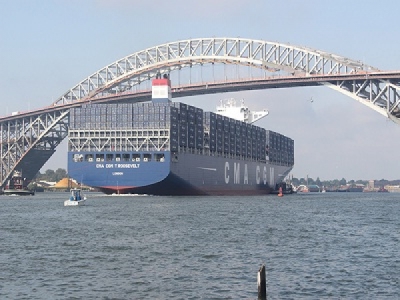
Posted on October 24, 2017
By Hugh R. Morley, JOC.com
On a sunny September day, the arrival of the 14,400-TEU CMA CGM T. Roosevelt — the largest ship ever to call at the Port of New York and New Jersey, and one that until recently couldn’t reach most of the port’s main terminals — heralded the dawn of a new era at the East Coast’s largest cargo gateway.
The June opening of the newly raised Bayonne Bridge, which was previously too low to allow ships of more than 9,500 TEU to get to three of the port’s four main terminals, capped a series of events allowing larger ships to call the coast. The expanded Panama Canal, allowing ships up to 14,000-TEU, opened in June 2016, two months before the Army Corps of Engineers completed a decade-long dredging project to deepen the port’s channel to 50 feet.
The major work may be completed, but the port’s ability to regain and expand market share is still far from assured. How it handles the ramp-up in business — and the intense logistical demands of quickly offloading and removing thousands of containers — will go a long way in determining the port’s future growth.
The port’s share of East Coast import volumes from Asia has slipped from 44.1 to 35.5 percent since 2009, even as the coast as a whole has seized market share from the West Coast, according to PIERS, a sister product of JOC.com within IHS Markit. East Coast ports — from Baltimore to Philadelphia and Savannah — have capitalized on New York-New Jersey’s history of sporadic congestion, higher costs, union walkouts, and longer turn times; truck queues of more than two hours are not uncommon. Some shippers are wary of using the port, wondering whether it’s up to the mega-ship challenge.
The summer collapse of a proposed portwide “gray” chassis pool and the failure to implement a portwide trucker appointment system — widely seen as a success at GCT Bayonne, the one New York-New Jersey terminal with such a program in place — only feed into those concerns.
“We actually see a lot of shippers looking for alternatives,” Thilo Trusch, senior director of trade management Atlantic for ocean carrier Hapag-Lloyd, told the JOC Container Trade Europe Conference in Hamburg last month. “We see that customers are trying to find options to New York in the expectation that something bad might eventually happen there.”
Officials at the Port Authority of New York and New Jersey are confident that the port’s size, location next to the nation’s largest consumer market, and ongoing efforts to upgrade and improve terminals and infrastructure will secure its existing business and fend off the competition.
“We are not going to just sit back because of our bigness and say, ‘We are always going to be big, that’s the way it goes,’ ” said Sam Ruda, the port authority’s assistant director. “We know what our issues are. We know about congestion. And there are opportunities to improve efficiency and turn time. We get all that. We are not here to say, ‘Victory.’ There is room for improvement.”
Source: JOC.com





